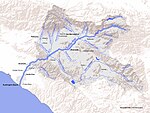Loma Linda University Medical Center

Loma Linda University Medical Center (LLUMC) is an academic hospital in California's Inland Empire region. Opened in 1905, it has a trauma center that admits over one million patients yearly, around 900 faculty physicians and over 1,000 beds. The main tower of the center was built in 1967 and is 18 stories high. Currently, the hospital is building two new hospital towers. It is one of the tallest buildings in the Inland Empire. Because of its height and white coloration, it is possible to view the main hospital building from various locations around the San Bernardino valley and mountains. Loma Linda University Medical Center made international news on October 26, 1984, when Dr. Leonard L. Bailey transplanted a baboon heart into Baby Fae, an infant born with a severe heart defect known as hypoplastic left heart syndrome. Baby Fae died a few weeks later; however, this effort led to the successful infant heart transplant program, with transplantation of human-to-human infant transplants. LLUMC is home to the Venom E.R., which specializes in snake bites. In 2014, LLUMC was ranked the 14th best hospital in California by the U.S. News & World Report.
Excerpt from the Wikipedia article Loma Linda University Medical Center (License: CC BY-SA 3.0, Authors, Images).Loma Linda University Medical Center
Anderson Street,
Geographical coordinates (GPS) Address Nearby Places Show on map
Geographical coordinates (GPS)
| Latitude | Longitude |
|---|---|
| N 34.0525 ° | E -117.26416666667 ° |
Address
Loma Linda University
Anderson Street
92350
California, United States
Open on Google Maps






